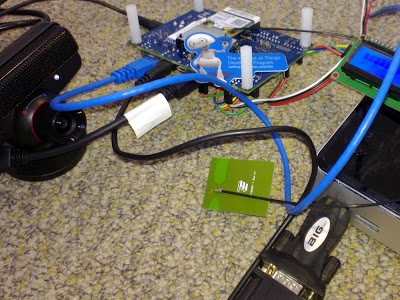Galileo developer kit for Internet Of Things and a developer program
 The week before last at Mobile World Congress, Intel President Rene James announced a program for developers of Internet Of Things. Any contests, prizes, hackathons, in short - a marketing program. But there was some news on the technical side. At MWC and Embedded World, our team demonstrated some new features in the development of software for IOT. We published two binary disk images (and the corresponding sources for self-assembly), which can significantly reduce the time required to configure the system to develop software for Galileo.
The week before last at Mobile World Congress, Intel President Rene James announced a program for developers of Internet Of Things. Any contests, prizes, hackathons, in short - a marketing program. But there was some news on the technical side. At MWC and Embedded World, our team demonstrated some new features in the development of software for IOT. We published two binary disk images (and the corresponding sources for self-assembly), which can significantly reduce the time required to configure the system to develop software for Galileo.For several months now, the Galileo fee can be bought fairly inexpensively, for example, in some European online stores . By purchasing a fee, a happy buyer gets a blue box, a power supply unit, and possibly a bunnyman stuffed toy. On Galileo, you can practically run out of the box code developed for the Arduino in the Arduino IDE . In flash, a minimalist Yocto Linux image is flashed on ucLibc and busybox, which can basically load and execute Arduino sketches. If suddenly the developer wants to install a more functional Linux distribution, the build and configuration will take several hours. Here, for example, is a very good instruction from Sergey Kiselyov, which describes how to compile Yocto with all sorts of gcc / g ++ / python / etc, so that one image can be used on the host (via chroot) and on Galileo.
We tested Yocto 1.5 again on Galileo, included recipes for some useful drivers and libraries for C / C ++ / Python / Node.js development, added some features that make installation and configuration easier, and made two disk images - one boot for Galileo micro SD cards, and one “live” USB image with Debian and customized Yocto Eclipse ADT, Yocto Hob - for development on a host. One of the main tasks that we tried to solve was to ensure that the time from unpacking the box to compiling and executing Hello IoT World does not exceed ten minutes.
Many ask, and here in general the Internet of Things? Galileo is a typical maker board, with its own advantages and disadvantages. In the comments to a recent article by my colleague, there was even a statement that with the help of Galileo, Intel is trying to compete with the most popular platform, Arduino. I believe that Galileo with our Yocto build can be used for IOT, because There is an IOT kit agent in the delivery and compatibility with Mashery . This facilitates the development of Intelligent gateway - a device that collects data from sensors, performs initial processing, and sends the result to the cloud.
')
In addition to disk images that can be downloaded from the Intel site, there is also a tangible avatar IOT Devkit. We have gathered some useful periphery in one box, and we have already distributed about 150 boxes to the most lucky visitors of MWC and EW in Barcelona and Nuremberg.
The set included a 2x16 screen, a PCIe card for a wireless network, a usb camera and a microphone, and all the necessary cables. (See title picture, but NUC is not included in the delivery :))
About the cables need to be said separately. Many Galileo customers are unhappy that a rare and expensive Audio (TRS 3.5mm) -RS232 cable is required to reach UEFI and grub. (Although I personally do not consider this a particular problem, for myself and my colleagues I soldered some of these cheap headphones) Well, then RS232-USB is also needed by those who do not have a serial port on their computer (which is not uncommon now). Some buy the TRS serial-USB cable, but almost always it turns out to be a TTL, rather than an RS232 adapter, and it does not work with the Galileo UART0. (C UART1 it works, but UEFI uses UART0). We also included the correct cable in the kit. After some time, when more massive hackathons begin, this set (possibly, with minor improvements) will be distributed to all participants, we plan to distribute so several thousand sets. (Check in the link above!)
If you carefully read the article on the IDZ program, then there are mentioned products Windriver: VxWorks and Workbench. At MWC, we demonstrated how they work for Galileo, but for now they can only be downloaded from Windriver with a corresponding contract. Also on Embedded World, I showed how a VI compiled by National Instruments Labview 2013 can run on Galileo, but you also need to download the Labview Runtime Engine separately from the National Instruments website.
By the way, in addition to Galileo on Embedded World showed another product from Intel on the Quark processor. This is Gateway for Internet Of Things, a more advanced product with a bunch of IO sorts including fieldbus.
It was the announcement and a short description of the Galileo IOT development kit, followed by two articles - about how we used this devkit to make one of the most visited demos on the MWC with toy car races,
The video disappeared from youtube, but the link remained: bcove.me/7fs0b04u
and more on how you can use Labview when programming for Galileo.
Source: https://habr.com/ru/post/214485/
All Articles